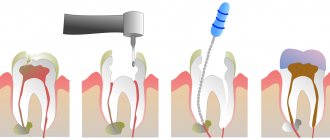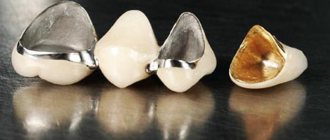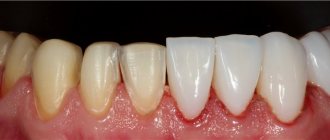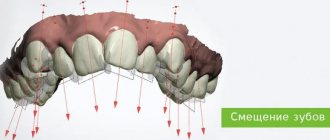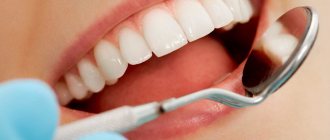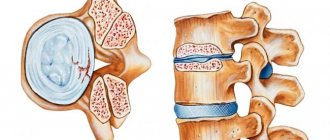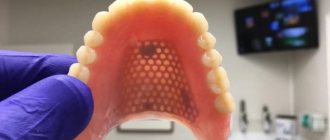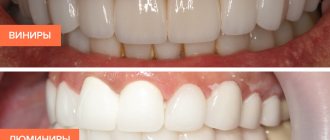Restoring the lower front tooth using a CEREC inlay
The work was quite serious. The tooth under the filling and the root of the lower canine were affected by caries.
First I removed the filling:
Then I removed the anchor pin:
In the video below you can see how the anchor pin was removed, and then I got ahead of myself a little, showing you a fitting of the finished CEREC module on the lower canine: The next step was to go quite deep inside the root, because the root of the lower canine was in caries.
IMPORTANT!
Each stage described above was accompanied by
3D scanning
with a Dentsply Sirona scanner, this is one of the best scanners in the world. The CEREC technological complex is equipped with just such a scanner. Scanning each stage, the CEREC hardware system stores all the data in memory, and when the time comes to plan and manufacture the missing tooth module, CEREC does this with filigree precision down to hundredths of a millimeter.
See for yourself by watching this short video:
Watch the video as I trace the border of this tooth.
The destroyed lower canine has a very complex geometry. However, the tooth will be completed using the “tooth only and missing module only” system. The canine will be installed and we will have a tooth that consists of only two components, no metal with one seam. The result will be a perfect lower canine. The restoration conditions are very difficult, deep, but in principle in this system it does not matter how deep they are, the main thing is that the tooth tissue is healthy. Our root has no caries, it has the classic dark color of the root, a non-carious color. Complex volumetric geometry in this tooth.
I create a tooth
, which will play the role of a reliable and strong fang for our patient. It has a super secure connection because there is only one seam, not two. In the video you can also watch the upper jaw, how we will close the teeth. You can also view contact points.
Yes, a very difficult tooth for a classic restoration. Difficult, but not for us. In CEREC, with a sufficiently professional level of the doctor, everything looks like “everything is the same”: this tooth for the Cerec system is simple like all the others. Well, in reality, of course, it looks and all the work looks fantastic:
As a result of the preparatory work I carried out, only the root of the lower canine 3.3 remained from intact tissue, and I made the missing module for it using CEREC technology: only the tooth and only the missing module without any anchor pins. It is this approach, without intermediaries in the form of pins, that ensures the best quality of treatment and further use of the tooth.
I created a CEREC inlay in A3.5 color with a color transition from the gum to the incisal edge. This transition ensured the absolute naturalness of the final design and the aesthetics of the tooth.
Sergey Samsakov
Removing the pins
Author: Ronald Forde
Root canals of endodontically treated teeth often contain broken instruments (instruments, silver posts, Lentulo, broken pins, etc.). The ability to remove broken instruments from the root system partially determines the success of root canal treatment. Abbott demonstrated that 9.4% of patients in an endodontic practice present for endodontic post extraction. Many factors influence the success of post removal, namely: the clinician's experience and choice of extraction technique and knowledge of tooth morphology, the type of cement used for luting, the shape (active or passive) and the type of post used (standard or customized).
When a hard object needs to be removed from a root canal, most general dentists refer such cases to an endodontist. Removing intact or broken pins is particularly difficult because previously prepared teeth have already been weakened by loss of hard tissue. Because dentists may have had little or no experience in removing posts, they are often concerned about the possibility of root fracture while attempting to remove the post, or they may not have the appropriate equipment for such a procedure. Many endodontists are also concerned about the possibility of root fracture when removing cemented posts, or they may believe that the extraction instrumentation is not up to the task.
According to Stamos and Gutmann, reasons for choosing a surgical approach include failure to remove or loosen the post after reasonable efforts have been made and cases where the post is large, long, or threaded and the crown and inlay appear intact. Quite often, the surgical approach carries its own problems (for example, intervention on the palatal root of a maxillary molar). In general, periapical surgery has a lower success rate than pin extraction.
If it is determined that an endodontically treated tooth is to be restored, the dentist must be aware of techniques for removing the foreign object from the canal and decide on the best solution for that particular situation. In reality, there is no true best method for all situations, and therefore the instrumentation and method of pin removal must be selected and tailored according to the situation. The goal will always be to preserve as much of the remaining tooth structure as possible. This factor is critical when working on a tooth where most of the root dentin has already been removed when the post was initially placed and the coronal portion has already been destroyed.
Pin removal tools have been on the market for a long time. They can be divided into 3 categories: mechanical, high-speed rotating and ultrasonic. It was and still is believed that pin extraction devices increase the risk of root fracture, although the Castrisos and Abbott study did not support this idea.
Attempting to remove pins or other foreign objects from a tooth canal may cause cracks, vertical root fracture, or perforation as a result of the direct mechanical effect of ultrasonic energy on the tooth structure. When any type of fracture occurs, it may be the formation of a new crack or from impact on a pre-existing weak point located on either the inner or outer surface of the root. It has been demonstrated that even the process of obturation of root canals creates intradentinal cracks. Altshul's study found that post removal using ultrasonic energy resulted in more root cracks (at the cemento-enamel junction) than in endodon.
Do you want to restore a tooth with a CEREC ceramic inlay?
8
or order a free call
Request a call
This is how the dental inlay for the lower canine turned out:
The inlay was fixed with double-curing cement Relix U200 (RelyX U200) - this is one of the most expensive cements, German cement. The patient was super satisfied. The restored tooth looks like its own:
All work FROM and TO was carried out in 1 appointment
, on a fresh tooth surface. Great job.
PS
As you can see in the video, the patient is facing the next stage of dental restoration. But we'll talk about this some other time.
Author:
Sergey Samsakov
orthopedic dentist
born 02/02/1989
Education:
2011 — Graduated from the Moscow State Medical and Dental University named after. A.I.Evdokimova
2012 — Internship in the specialty “Orthopedic Dentistry”, Moscow State Medical University named after. A.I.Evdokimova
2014 - Residency in Orthopedic Dentistry, Moscow State Medical University named after. A.I.Evdokimova
Tab
This is also a prosthetic design that imitates part of a tooth. Used for teeth located behind the canine teeth.
There are:
- Restorative inlays - to recreate the correct shape, bite and natural shade of the tooth;
- Stump inlays are placed under the crown and serve as the foundation for it.
The difference from the pin is in the device - the inlays consist of two parts - the pin itself and an element that replicates the tooth. The manufacturing process takes place under pressure at high temperatures. The root part is an attachment for the root and looks like a rod. The upper element follows the shape of a crown.
More examples of treatment
Caries under filling Depulped tooth Absence of the crown part of the tooth
Restoring a tooth with a CEREC inlay after removing a metal inlay
Tooth 3.5 initially had a filling; a metal inlay was installed in the tooth, quite deep, and a filling on top. This is a “puff sandwich”.
Module crown + tooth root CEREC Removal of metal inlay
more details
Pulpless tooth Destruction of the front tooth in the upper jaw
Restoring a front tooth damaged by super glue with a CEREC inlay
Superglue is toxic to the body. Is it possible to glue a piece of tooth with this glue? Of course not. But you can easily ruin a tooth!
Module crown + tooth root CEREC Professional hygiene
more details
Content
- Details about the pin
- Details about the tab
- Materials for production
- What the inlay and pin have in common
- Differences
- What to choose - pin or tab
Currently, dentists offer many options for prosthetics and dental treatment. Modern technologies can solve almost any problem. It is important to choose the best option for a particular case. If treatment of a decayed tooth is required, the choice is between an inlay and a pin.
PROMOTION
Dental restoration, installation of fillings
from 2200 rub.
Do you want to restore a tooth with a CEREC ceramic inlay?
Always at your service - Sergey Samsakov, orthopedic dentist with more than 10 years of successful experience, Moscow. Expert in 3D digital smile modeling, veneers and CEREC technology.
Patients come to me from all over Russia:
Dental pins - what are they?
Today, doctors have a wide selection of dental pins, varying in shape, material and area of application.
Dental pin materials
- Metal.
The most popular options: titanium, brass, palladium and precious alloys. - Metal-free.
They are made from gutta-percha, ceramics, fiberglass and carbon fiber.
Forms
- screw
- cylindrical
- conical
- combined
Recovery methods
- pins for tooth crown
- tooth filling on a pin
Mounting methods
- Active.
Threaded pins are screwed into the root canal, thereby achieving a tighter fixation. However, there is a risk of perforation of the canal walls. - Passive.
A more gentle (but less reliable) method of fastening. The pin is placed inside the root canal and fixed using a special compound.
What to do if a tooth with a pin hurts?
Painful sensations may well occur after installation of the pin, since surrounding tissues were affected during the treatment process. Often, unpleasant sensations occur after depulpation, especially with the use of arsenic. A tooth without a nerve and a pin should not hurt, since it is dead. If a tooth hurts after installing a pin and these sensations do not go away for several days, there is a risk that the treatment was carried out with errors and complications arose. In this case, you should consult a doctor as soon as possible.
What to do if a temporary bridge falls out
If the temporary bridge falls out, then there is nothing to worry about. After all, it is glued to temporary cement, which has weaker fixing properties. Therefore, you need to contact an orthopedist to glue the structure in place. Or, if a permanent prosthesis is already ready or the implants have taken root, then the temporary bridge will not be put back, but the permanent one will be fixed immediately.
Complex on 4 OSSTEM implants with delayed loading - from RUB 170,000.
Complex implantation Osstem (South Korea) with delayed loading after 4-6 months.
Guarantee for the doctor’s work - unlimited Call now or order a call
Opening hours: 24 hours a day - seven days a week
How much does it cost to put a crown on a post?
The price of the finished solution directly depends on the materials of the pin and crown. The cost of a regular anchor pin is 500 rubles, but for a fiberglass one you will have to pay more than 1000 rubles. But these figures pale in comparison with the range of prices for crowns. If ordinary metal-ceramics costs 6–8 thousand, then products made of ceramics and zirconium will cost three times more. All preparatory manipulations will need to be added to the final amount.
An E-Max ceramic crown on a fiberglass pin, together with all stages of treatment, can cost 30,000 rubles and even more if we are talking about a VIP-class clinic. You can also choose a budget option with a metal-ceramic crown and an anchor or titanium pin. This solution will cost from 12,000 rubles, but is not suitable in all cases.
Causes of crown loss
There are many factors that can cause a crown to fall out. The most common ones include:
- resorption of the cement composition that was used for fixation;
- breakage or abrasion;
- excessive pressure;
- the use of temporary material instead of permanent;
- formation of a carious process under the product;
- violation of the rules in the process of creating a structure or incorrect grinding of a dental unit.
A crown can fall off for several reasons. But only a specialist can determine what exactly led to this condition. In this case, you should not blame only the technician or the orthopedic surgeon. The patient himself can also become the culprit of the incident if all recommendations are not followed or due to negligence.
Crown loss is caused by cement resorption, abrasion, product breakage, high blood pressure, caries, application of temporary material, and dentist errors.
The problem can be eliminated in several ways: reinstallation of the structure, removal of the tooth with complete destruction of the stump and root.
When the client contacts him again, the dentist must take a more responsible approach to the process of preparing the tooth for prosthetics and correctly fixing the structure using better quality material.
If the crown is handled improperly (cracking nuts with the tooth or opening bottles with it), it may break.
However, you should not try to remove the remaining part of the crown yourself, so as not to damage the tooth stump.
Dentist
Novikova Olga Alexandrovna
8 years of experience
The dental technician, in turn, should not neglect all the rules and stages of creating a product. The patient is required to strictly follow all recommendations for oral care, perform high-quality hygiene procedures and exclude solid foods from the diet.
How is a pin inserted into a tooth?
Installing a pin into the root of a tooth is a rather labor-intensive process, including diagnosis and preliminary treatment of canals. Further actions depend on the treatment method. The first option is to place a pin and build up the tooth using composite materials. The second option, a tooth prosthesis on a pin, involves installing a crown. Dental prosthetics with a pin is not performed. The role of the prosthesis is performed by the crown, and the pin is only an additional supporting element. Finally, the extended tooth on the pin is polished and brought into proper condition. In the case of a crown, the doctor makes sure that the prosthetics was successful.
What needs to be done to make the bridge last as long as possible
In order to extend the service life of the bridge, we must not forget that although it is an artificial structure, it should be treated like “natural” teeth. That is, do not load the bridges with excessively hard and stretchy food, regularly brush your teeth with a brush and toothpaste. Another important rule is that you need to visit an orthopedic dentist every 6 months. During a preventive examination, the doctor will examine the condition of the oral cavity and installed dentures, and will carry out professional removal of tartar and plaque.
1Yamamoto M. Basic technique for manufacturing metal-ceramic dentures, 1998.
Your questions and answers
QUESTION Hello, the bridge fell out of the teeth along with the pins. Can it be put back or not? And what is the best way to do this? Oksana
ANSWER Hello, Oksana. It's best not to try to glue the bridge in place yourself, because... This is fraught with complications, and consult an orthopedic dentist. Because there are many nuances due to which the old prosthesis can either be put back or not be used further (i.e., a new one can be made). But, given that your bridge fell out instead of the pins, most likely you won’t be able to put it back in place.
Author: Sambuev B. S. (Thank you for your help in writing the article and the information provided)
Relationship between loss and service life
Dental bridges can fall out due to natural wear and tear or the end of their life. On average it is 5 years. And with good oral hygiene and careful treatment, the bridge will last up to 10 years. If the bridge is supported by implants, the service life increases. For ceramic and metal-ceramic it is at least 10 years, and for zirconium dioxide and ceramic-composite – from 20 years.
“My mother built golden bridges for herself back in the 90s. So, they stayed with her for almost 20 years. Either the doctor was such a good one, or she was taking care of her teeth. But she definitely never ate nuts. And I installed metal-ceramic ones in 2014. And they fell out after only 6 years. The doctor was able to glue them in place, but I understand that it is no longer so convenient. We'll probably have to change it."
Anastasia G., review from gidpozubam.ru
Is it possible to glue a crown at home?
To place a crown or bridge, dentists use special materials that allow the orthodontic product to be temporarily or permanently secured.
Temporary type fixation is used to provide an opportunity to evaluate the structure while it is being worn. If there are no problems, the product is attached to permanent cement.
However, there are often cases when the crown falls out at home. The patient immediately begins to panic, especially if the crown was placed in the frontal area. In this case, there is no need to worry too much.
Why can our articles be trusted?
We make health information clear, accessible and relevant.
- All articles are checked by practicing doctors.
- We take scientific literature and the latest research as a basis.
- We publish detailed articles that answer all questions.
To glue the product in place, you can purchase a gel at the pharmacy, which is similar in composition to the temporary cement used by orthopedists. It is applied from the inside and pressed against the tooth. After the material has hardened, the excess is carefully removed.
To get a permanent crown, it is important to visit your dentist without delay.

